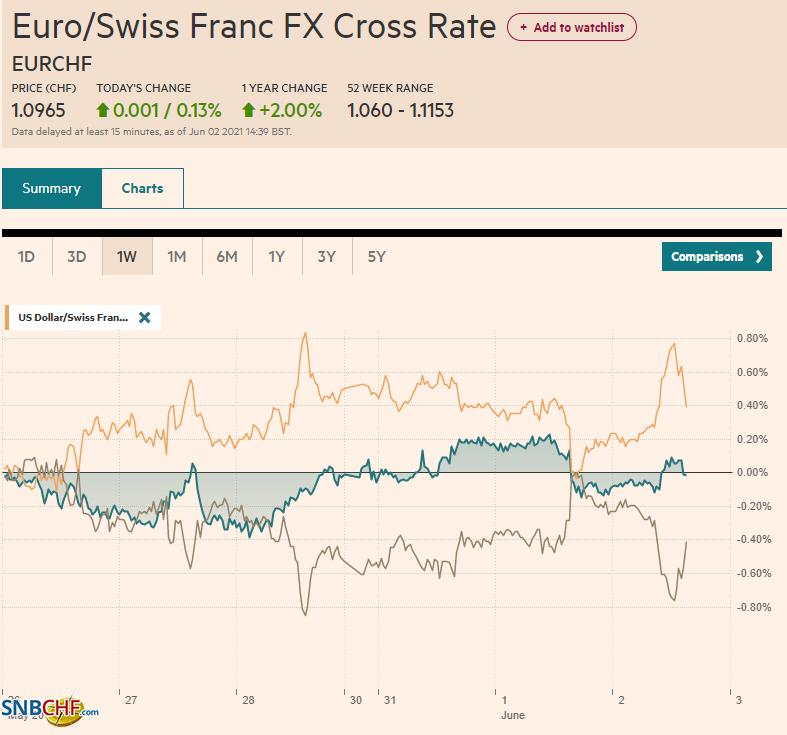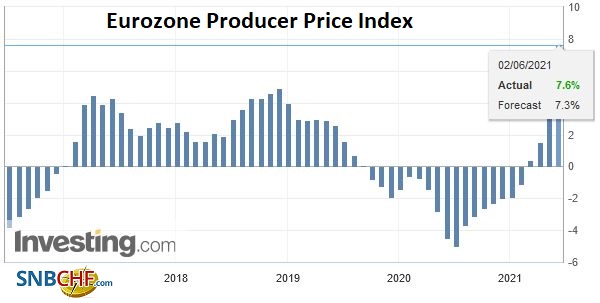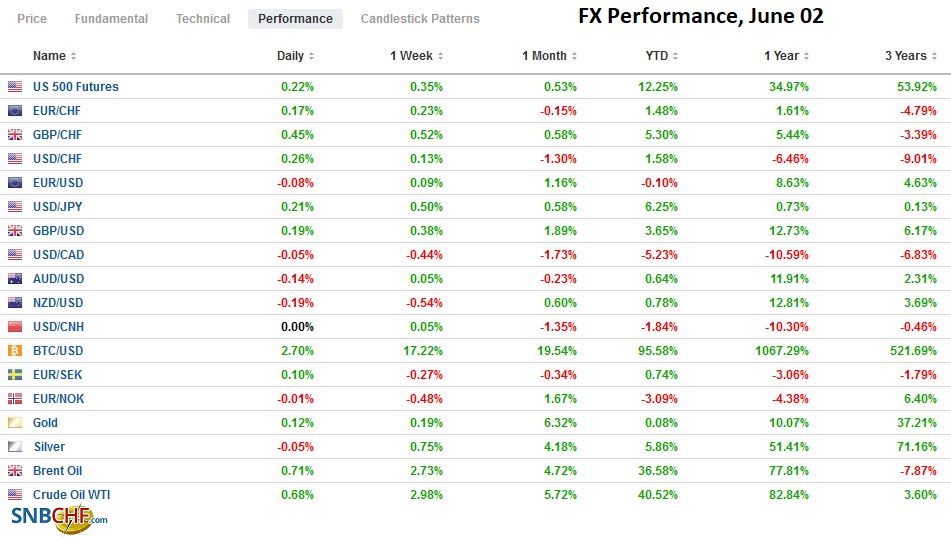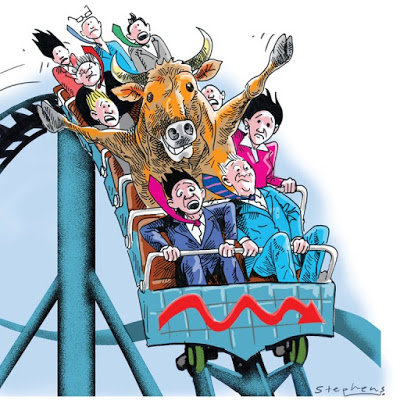Swiss Franc The Euro has risen by 0.13% to 1.0965 EUR/CHF and USD/CHF, June 02(see more posts on EUR/CHF, USD/CHF, ) Source: markets.ft.com - Click to enlarge FX Rates Overview: The US dollar is enjoying broad, even if not large, gains today following yesterday’s recovery from three-year lows against sterling and four-year lows against the Canadian dollar. The greenback is firmer against all the major currencies. The Australian and New Zealand dollars the weakest, even though Australia reported stronger than expected Q1 GDP and its stock market was among the strongest in the region with a 1% gain. Emerging market currencies are also weaker. Turkey’s president, who has dismissed four central bank officials in the past two months, renewed his call for rate
Topics:
Marc Chandler considers the following as important: $CNY, 4.) Marc to Market, 4) FX Trends, autos, Currency Movement, EUR/CHF, Eurozone Producer Price Index, Featured, Federal Reserve, newsletter, U.K., USD, USD/CHF
This could be interesting, too:
Nachrichten Ticker - www.finanzen.ch writes Die Performance der Kryptowährungen in KW 9: Das hat sich bei Bitcoin, Ether & Co. getan
Nachrichten Ticker - www.finanzen.ch writes Wer verbirgt sich hinter der Ethereum-Technologie?
Martin Hartmann writes Eine Analyse nach den Lehren von Milton Friedman
Marc Chandler writes March 2025 Monthly
Swiss FrancThe Euro has risen by 0.13% to 1.0965 |
EUR/CHF and USD/CHF, June 02(see more posts on EUR/CHF, USD/CHF, ) Source: markets.ft.com - Click to enlarge |
FX RatesOverview: The US dollar is enjoying broad, even if not large, gains today following yesterday’s recovery from three-year lows against sterling and four-year lows against the Canadian dollar. The greenback is firmer against all the major currencies. The Australian and New Zealand dollars the weakest, even though Australia reported stronger than expected Q1 GDP and its stock market was among the strongest in the region with a 1% gain. Emerging market currencies are also weaker. Turkey’s president, who has dismissed four central bank officials in the past two months, renewed his call for rate cuts and spurring a slide in the lira to new record lows. The Israeli shekel is also heavy ahead of the deadline for the opposition to propose a new coalition. The JP Morgan Emerging Markets Currency Index is lower for the second consecutive session. It has not suffered back-to-back losses since May 11-12. Asia Pacific equities were mixed, with China, Hong Kong, and India heavy. Philippine shares rallied more than 3% as social restrictions eased and foreign investment returned. Europe’s Dow Jones Stoxx 600 is firm but consolidating new yesterday’s record high. US futures are little changed. The US 10-year yield is little changed after pulling back from near 1.64% yesterday. It is holding above 1.60% but had closed below it in three of last week’s five sessions. European yields are a touch firmer today. Gold is struggling to maintain the foothold above $1900, and oil prices are firm, with July WTI solidifying its hold on the $68-handle. China’s ability to stem the rise of industrial commodities is being tested. Iron ore gained for the fourth consecutive session, and steel rebar has risen in three of the past four sessions. Copper is off for the second session, and lumber prices fell in the US yesterday for the sixth consecutive session. The CRB Index is at its best level since 2015. |
FX Performance, June 02 |
Asia Pacific
Australia’s economy expanded by 1.8% quarter-over-quarter in Q1 21, which was a little faster than expected, and Q4 20 GDP was revised to 3.2% from 3.1%. Consumption and residential investment accounted for almost two-thirds of the growth. The relaxation of social restrictions spurred demand for services while the purchases of goods slipped. Savings were tapped. However, the second-most populous state (Victoria) has re-imposed and extended a lockdown that warns of slower growth in the current quarter. In addition to household consumption, inventories were rebuilt (0.7 percentage-point contribution to GDP). With inventory-sales ratios returning to pre-crisis levels, it is unlikely to be repeated.
The vaccination efforts in Japan are accelerating. The seven-day average of vaccines has quadrupled over the past couple of weeks. Reports suggest that Japan is now vaccinating around half a million people a day, and now more than 10% of the population has at least one jab. Some work suggests that after a country surpasses the 10% mark that the stock market rallies. Japanese officials seek to double the inoculation rate to one million a day by the middle of the month.
A small base for the dollar has been formed around JPY109.30-JPY109.40 in recent days. Although it briefly traded above JPY110 at the end of last week, it has not mustered the strength so far this week. There is a $1.23 bln option struck that expires tomorrow.
The Australian dollar rose to a five-day high just shy of $.07775 and was greeted with strong selling pressure that knocked it through yesterday’s low near $0.7730. A close below there would constitute a bearish outside day. Initial support is seen around $.7700. Last week’s low was set near $0.7675.
The Chinese yuan fell for the third consecutive session, though the losses are minor. The onshore yuan eased by about 0.05% today to bring the three-day decline to about 0.25%. The reference rate was set at CNY6.3773, back to the more normal deviation from the bank model’s survey by Bloomberg of CNY6.3777.
Europe
The UK has been given the approval to begin the ascension process to join the Comprehensive and Progressive Agreement for Trans-Pacific Partnership (CPTPP). Japan’s foreign minister Nishimura confirmed the decision. If the UK were to join, the CPTPP would equal the EU in terms of the GDP covered. The UK enjoyed a trade surplus with the CPTPP members in Q1. China has made some preliminary overtures toward wanting to join as well. When then-President Trump withdrew from negotiations, he noted that both Democrat candidates (Clinton and Sanders) had opposed the TPP during the 2016 campaign. The Biden administration shows little interest in re-joining. Instead, it appears it is seeking to strengthen bilateral ties. The first two foreign leaders to be hosted by the White House are from the region (Japan and South Korea).
As we noted yesterday, the Nationwide Building Society index showed house prices were rising at their fastest pace since 2014. Deputy Governors of the Bank of England, Cunliffe and Ramsden, expressed concern. It clearly is on their radar screen for considering to pullback stimulus. Last month the BOE announced it was slowing its bond purchases. The 10.9% year-over-year gain in May was double the rise anticipated by economists. Other countries, including Canada, Australia, and New Zealand, are also wrestling with surging house prices. House prices are rising rapidly in the US as well, but the Federal Reserve appears to be in no hurry to reduce the mortgage-backed securities it is buying every month ($40 bln).
EurozoneEurozone producer prices rose 1% in April to bring the year-over-year rate to 7.6% from 4.3% in March. Yesterday’s preliminary May CPI reading of 2% was a touch higher than expected. The ECB meets next week, and there is much teeth-gnashing whether it will slow its bond purchases from the accelerated pace over the past three months. We caution against exaggerating the significance of the decision. The PEPP program runs through the end of next March, and most importantly, over the past three months, the euro, yields, and premia over Germany have widened. The euro reversed lower yesterday after briefly trading above $1.2250. It left a bearish shooting star candlestick in its wake, and follow-through selling today has taken the single currency to $1.2170 to test the 20-day moving average. It has not closed below this moving average in nearly a month. The month-end induced low from last week was slightly below $1.2135. The $1.2125 area represents the midpoint of last month’s rally. Sterling recorded a bearish outside down day yesterday, trading on both sides of Monday’s range and settling below Monday’s low. Selling today has extended the losses to $1.4125, near its 20-day moving average. Sterling has not closed below the 20-day average since April 30. A convincing break of the $1.4090 area signals a test on $1.40. |
Eurozone Producer Price Index (PPI) YoY, April 2021(see more posts on Eurozone Producer Price Index, ) Source: Investing.com - Click to enlarge |
America
Pressure on the very short-end of the US curve has been evident for some time, but now a key threshold has been violated, which in turn can see a policy response. The effective Fed funds rate (weighted average) slipped to five basis points at the end of last week. When the Fed funds are within five basis points of its lower bound, the Fed has moved to secure the floor by raising the rate it pays on reserves (all reserves, not just on the excess reserves) and/or tweak the rate on the reverse repo operations. The uncertainty about the Fed’s response seemed to have impacted the T-bill sales where the three-month bill was sold for two basis points while the six-month bill went for 3.5 bp.
The US and Mexico report May auto sales today. US auto sales are expected to slow from the heady 18.51 mln unit pace in April to 17.40 mln last month. In the first four months of 2021, US sales have averaged 17.14 mln (seasonally adjusted annual pace). This compares with 13.4 mln last year and 16.76 mln in 2019. Mexico’s domestic vehicle sales averaged 85.7k a month through April. In the same period last year, sales averaged almost 83k, while in the January-April period in 2019, sales were averaged 107.9k.
The US Beige Book, prepared for the June 15-16 FOMC meeting, will be released. It is expected to provide anecdotal evidence that despite April’s disappointing employment data and some weakness in data surprise models, the US growth is accelerating with labor shortages and supply chain disruptions evident. Fed officials are saying that talks about tapering can begin in the coming months. Most market observers, according to surveys, see this starting in earnest either in late August or the September 21-22 FOMC meeting.
The US dollar slipped to new four-year lows against the Canadian dollar. Still, key support at CAD1.20 held, and the greenback staged an impressive bounce, leaving behind a bullish hammer candlestick. Buying today has been limited. The 20-day moving average (~CAD1.2095) remains intact. The US dollar was testing it last week but has not closed above it since April 20, the day before the Bank of Canada delivered a hawkish surprise to the market. Above the CAD1.2100 area, the upper end of the recent range is seen closer to CAD1.2145.
The US dollar also recorded an outside up day against the Mexican peso yesterday, and follow-through buying today lifted it above MXN20.00 for the first time this week. The pre-weekend high was near MXN20.0770. The latest polls for this weekend’s election shows the AMLO’s Morena party, which has 48% of the seats (239) in the lower chamber, is likely to be close to a supermajority (334 seats) when combined with the coalition partners (Green Party and Worker’s Party).
Graphs and additional information on Swiss Franc by the snbchf team.
Tags: #USD,$CNY,autos,Currency Movement,EUR/CHF,Eurozone Producer Price Index,Featured,federal-reserve,newsletter,U.K.,USD/CHF









